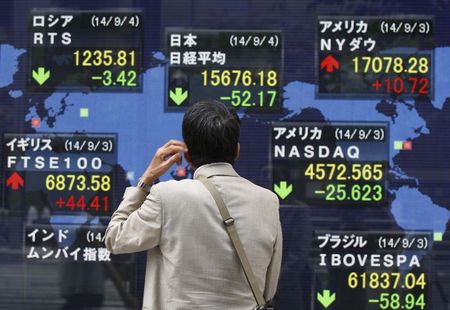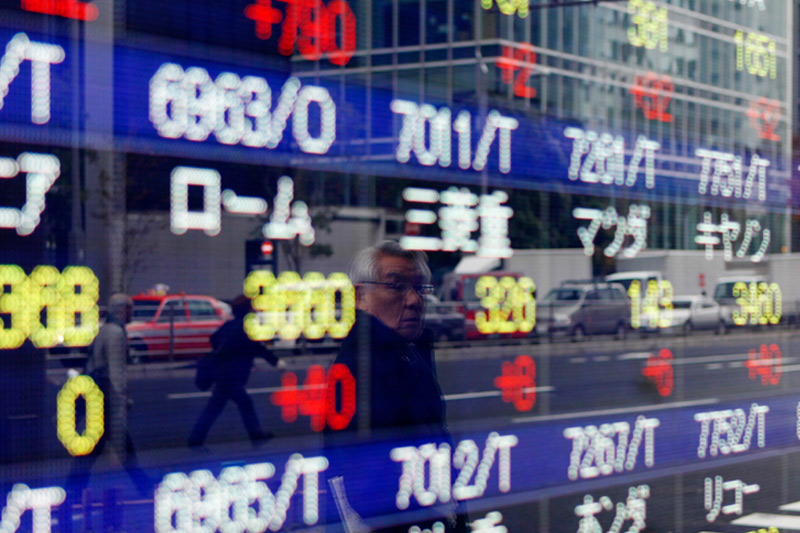By Wayne Cole
SYDNEY (Reuters) - Asian shares recouped early losses on Tuesday while commodities won a break from recent selling pressure after a reading on China's massive factory sector outpaced the market's bleak expectations.
The HSBC flash reading on manufacturing (PMI) for September rose to 50.5, from 50.2 in August and confounding forecasts for a dip to 50.0.
The market had been braced for something even worse and the relief helped Chinese stocks move into the black and the Australian dollar hop higher. The Asian giant is Australia's single biggest export market and investors often use the currency as a liquid proxy for China plays.
Annette Beacher, head of Asia-Pacific research at TD Securities, noted the flash PMIs had averaged 50.9 for the third quarter, a pickup over the previous quarter's 49.6.
"After the dismal industrial production print for August, financial markets were increasingly of the view that China is slowing at a more rapid pace than desired, so today's print provides a welcome offset," said Beacher.
The Shanghai Composite Index (SSEC) added 0.9 percent and the CSI300 (CSI300) of the leading Shanghai and Shenzhen A-share listings bounced 0.8 percent.
Australia's main index (AXJO) swung smartly higher to be up 1 percent, while MSCI's broadest index of Asia-Pacific shares outside Japan (MIAPJ0000PUS) gained 0.2 percent. Japanese markets were shut for a holiday.
In Europe, financial spreadbetters expected only minor early moves for the FTSE 100 (FTSE), DAX (GDAXI) and CAC 40 (FCHI).
Hindering sentiment was news the United States and partner nations were carrying out the first air strikes against Islamic State targets in Syria, a far more complicated front in the battle against militants.
Shares had begun badly after Wall Street took a dip overnight. The Dow (DJI) had ended Monday down 0.62 percent, while the S&P 500 (SPX) lost 0.8 percent and the Nasdaq (IXIC) 1.14 percent.
The drop in the S&P was the biggest one-day decline since early August and was caused in part by a soft reading on U.S. existing home sales which hit shares in building companies. [TOP/CEN]
US DOLLAR IN DEMAND
The soggy data gave a fillip to Treasuries, as did comments from New York Federal Reserve bank president William Dudley that there was still excessive slack in the economy so any increase in rates should be done cautiously.
Dudley played down the importance of the various interest rate projections of Fed members released last week which some in the market had taken as a signal of a hawkish turn.
That helped yields on two-year paper (US2YT=RR) ease back to 0.553 percent and away from a top of 0.597 hit last week.
Yields on 10-year Treasury notes (US10YT=RR) dipped to 2.56 percent, from 2.59 percent late Friday.
Dudley also said the steady rise in the dollar could complicate the Fed's job, potentially hurting U.S. economic performance and pushing down inflation.
The currency has been on a tear recently thanks to the diverging outlook for U.S. rates and those in Europe and Japan, where policy is set to remain super-easy and might even be loosened further.
Measured against a basket of currencies <.DXY> the dollar had climbed for 10 weeks straight, the longest streak since the index was created in 1971.
On Tuesday, the dollar was taking a breather at 108.74 yen
The Australian dollar recouped just a little of its recent losses on the China survey and nudged up to $0.8913
Likewise, gold inched higher to $1,219.15
Brent crude oil for November delivery

Ample supply and slowing economic growth in Europe and China had been outweighing expectations of a cut in oil output from the Organization of the Petroleum Exporting Countries (OPEC).
(Editing by Eric Meijer)
